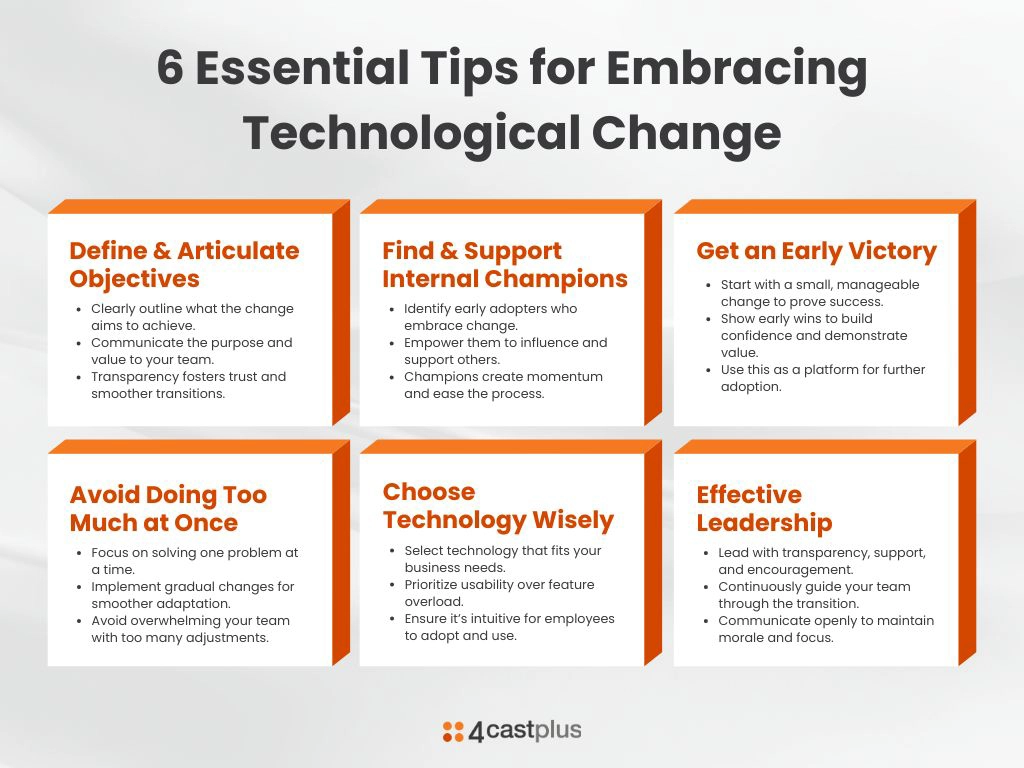Read In 8 Minutes
Overcoming Discomfort for Growth & Success
Change is an inevitable part of life in every aspect of life. To embrace change is to see it as an opportunity, a promise of hope to improve or try new things. And people love the idea of change. But it also requires hard work and perseverance. By embracing the unknown, we can evolve, adapt, and learn new things about ourselves and others. Better yet, we’ll see growth and encouragement to live life or work differently.
It’s almost human nature to dread change at some point. The feeling of being pushed out of our comfort zones and to let go of control. Control is what helps us make sense of the world, from the mundane to the chaotic. In an organization, change is complicated because it impacts multiple people at one time. Each person also manages change differently, some who experience negative effects on their physical and mental health, which can affect others around them at the office.

Technology Change
Innovation has driven change in the workplace at an unfathomable speed. With new technology that boasts different apps, channels and mediums, platforms and softwares to be used, it’s a wonder how employees are keeping up with change personally and professionally.
There are a number of factors that can cause resistance to new technological developments in the workplace. Primarily, we focus on the obstacles, the difficulties and challenges that will arise like learning a new system, to adapt to a new way of thinking with a different software or platform layout.
For example, that mixed feeling of an adrenaline rush yet dread when your faithful laptop has finally seen better days. On one hand, you’re excited to upgrade what feels like your lifeline. On the other hand, the idea of transitioning, transferring all of your data, and reloading information and applications is overwhelming. So you delay the inevitable – where one day, your hand is forced to take on a new technology; a new beginning that is daunting because it challenges your routine and day-to-day life.
Tackling Change in the Workplace
Most organizations behave similarly in how they process and operate before a defining moment or trigger event forces them to take action. They know they need to upgrade their technology, systems and processes, but they delay it and delay it because of the fear of disruption. It’s a difficult concept to accept, that their employees are given all the right tools, and they’re humming along at peak productivity; but the fear of the upheaval paralyzes them from acting.
It’s time to be realistic. What’s best for an organization is to anticipate its needs before a trigger event. And likely, that involves upgrading the business technology and process improvements as soon as possible. However, part of that reality is knowing that there’s never a good time to introduce change. The life of an organization never slows down and waiting until the “perfect time” will never come. So take the plunge, and improve the process for you and your employees. It’s time to take hold of the opportunities to uncomplicate your business.
Great! Now that you’ve decided to move forward with this transition, it’s time to make it as painless as possible. There are obstacles that you’ll experience and it’s expected there will be questions or resistance along the way. So what does success look like and how do you get there?
Discover More About 4castplus Technology
6 Essential Tips to Support Change
There are tried-and-true tactics that many businesses can attest to. Here at 4castplus, there are recommendations we have for leaders to make sure technological and system changes will go well for their company:
- Define and articulate objectives
- Find and support internal champions
- Get an early victory
- Avoid doing too much at once
- Choose technology wisely
- Effective leadership

Define and Articulate
When a decision has been made to change the entirety of how employees operate day-to-day, the disruption can lead to uncertainty and confusion. As a leader, you have a responsibility to articulate what you’re trying to achieve and why this will help the business. Know your objectives and how you plan to achieve your goals with the support of the team. Not everyone will need to know the entirety of the business plan and analysis, but they’re owed a transparent overview to understand the value and purpose of the changes to be made.
An example of the overarching goals could be:
- Improve efficiency and communication
- Differentiate the business for a competitive edge
- Improve the quality of the product/service
- Use better tools for employees to work efficiently and effectively
- Provide management reporting and analytic capabilities to make better strategic and financial decisions
Communication is key because if you show employees respect by explaining the new changes, the likelihood to embrace change will be higher. This effect will lead to trust in leadership, and support to transition into a new system and process.
Find Your Internal Champions
One of the themes in this article has clearly outlined that not everyone is ready to accept change. And that’s okay! These barriers might take time to break down for some employees, but the effort is not lost. Find a leader or leaders who have a positive perception and embrace change. Empower these early-adopters by harnessing their motivation and positivity to influence and support those who are hesitant to change. There is a greater chance of success to move the needle with champions who are willing to work together for the good of the company.
Get an Early Victory
Bringing in a new concept for the organization can be a daunting task not only for the employees, but for the leader too. There needs to be a foundation that this new way of working will bring value to your organization. A pilot program on a smaller scale can help with a quick win to show it will actually work. This ‘early victory’ means it:
- is a proof of concept to ease fears and to validate the technology
- identifies issues or mistakes that need to be addressed early on with a controlled group
- acts as a platform for future growth within the organization
- provides measurable results with statistical and analytical credibility
Avoid Doing Too Much at Once
Often many companies will leave system and process issues for too long. And when they finally decide to act, there’s a lofty expectation to fix everything at once. The attempt for big changes with ambitious plans to take place can also lead to a multi-year implementation that is expensive and extremely disruptive. Big ERP systems prey on this scenario. The newer technology model is more specialized than the older SAP solution that gets its hooks into the whole organization. Leaner software solutions that solve a specific problem in the enterprise are becoming more attractive in today’s forward-thinking company.
The technology needs to target a specific problem and integrate well with other related solutions that target a connected enterprise challenge. What makes sense? Solve achievable problems one at a time. Target. Plan. Execute. Repeat. And continue until the business units have the tools they need.
It’s unrealistic to rely on one vendor to solve your entire business. If you think you’re confused, your software vendor likely knows less about your business than you do.
Choose Technology Wisely
Whichever technology solution you decide to go with, you will need to identify which is the best fit for your organization. A common mistake that’s made when choosing software is to consider packages with the highest percentage of “must have features”. It’s best to be careful because feature gaps are easy to overcome, while usability gaps are monumental.
The biggest challenge any organization faces is for employees to willingly abandon the familiar systems and processes that they know, and to switch to a new one. If the new system is difficult to use or it is complicated, they will resist or refuse to adapt. That is the last thing any leader wants to experience. If the new technology brings value and it’s easy for the employee to use, it will be far more streamlined and accepted. They need to see and understand how it’s beneficial to them and makes their job easier, and that it brings value to the organization.
It Comes Down to Leadership
As a leader, part of the challenge is to navigate and help your employees through the transition. The best you can do for the team is manage and support them to be successful.

What does that look like? It’s best to make continuous incremental improvements rather than waiting it out for a surprise event or pivotal moment. The risk, cost and disruption are minimized if you stay on top of it and address it as a part of your corporate strategy. Ideally you make constant measured upgrades based on feedback and observations. You have to accept that ongoing technological advancements will be part of your leadership team’s strategic agenda.
Lastly, communication and transparency are essential for a smooth transition. Find the best way to motivate your team to adapt to embrace change. With positive reinforcement and support, it can help ease the team to have a positive perception for the changes and see the value in it. Although you won’t be seeking their approval, asking for their input and participation are imperative. Enable and empower them with trust and responsibility, and you’ll see the best outcome that you were anticipating.
 Platform
Platform Solutions
Solutions Owners
Owners Contractors
Contractors Engineering/EPCM
Engineering/EPCM Professional Services
Professional Services Resources
Resources White Papers
White Papers Case Studies
Case Studies Blog
Blog Videos
Videos Frequently Asked Questions
Frequently Asked Questions Company
Company About
About

